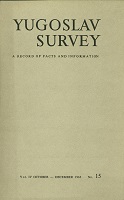VESTMENT IN THE POST-WAR PERIOD (IN YUGOSLAVIA)
VESTMENT IN THE POST-WAR PERIOD (IN YUGOSLAVIA)
Author(s): Author Not SpecifiedSubject(s): National Economy, Economic history, Political history, Economic policy, Post-War period (1950 - 1989)
Published by: Jugoslovenski Pregled
Keywords: Post-war period; Yugoslavia; economic development; agriculture; farming; industrial production; investments;
Summary/Abstract: Before the war Yugoslavia was at a very low level of economic development and the structure of income and its per capita value ranked her among undeveloped agrarian countries. In the formation of total national income agriculture contributed 53 per cent and industry only 26 per cent. About 75 per cent of the population lived from farming. In 1938, the per capita income amounted to about 115 dollars. This structure of the economy meant that the country’s accumulation capacity was very small and the rate of investment in relation to gross national product very low. On account of this the economy developed at a very slow pace; from 1923 to 1939, national income rose at an average rate of about 2.5 per cent while the average annual growth rate of industrial production was 3.8 per cent
Journal: Yugoslav Survey. A Record of Facts and Information
- Issue Year: IV/1963
- Issue No: 15
- Page Range: 2153-2172
- Page Count: 20
- Language: English

